KEITH FENDER reports on the way Continental Europe’s railways reacted to coronavirus
The coronavirus pandemic originating in China saw the first European outbreak in Italy in early February. By mid-March multiple countries in Europe had imposed ‘stay at home’ lock downs for all but key workers.
Reduced timetables became common: in Ireland for example, a reduced timetable was introduced on 30 March that saw the withdrawal of all services on the Waterford to Limerick Junction and Limerick to Ballybrophy (via Nenagh) routes. Services between Dublin and Belfast continued with four train pairs operated using Northern Ireland Railways CAF DMUs in place of the usual ‘Enterprise’ push-pull sets. As in the UK, use of public transport was only permitted for specific work or shopping / medical purposes, with the Gardaí able to enforce compliance.
By late March passenger numbers in many EU countries were down to 15% of pre-pandemic levels and the closure or severe restriction of passenger rail services had become a global phenomenon – Indian Railways, for example, closed its network for over a week in late March.
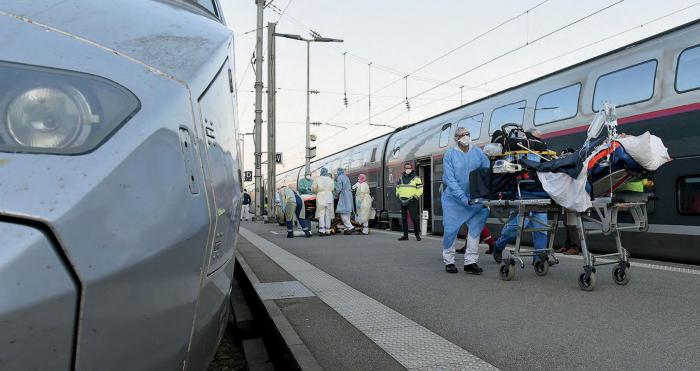
INTERNATIONAL CONNECTIONS DWINDLE
By late March the number of international rail routes still in operation was small – and on all routes the service on offer was a fraction of the normal service. For example, Austria still had some trains to Hungary – but none to any of its other neighbouring countries, including Germany.
Eurostar progressively reduced services in March to a point where a single train pair between London and Paris was on offer on some days. From late March the French Government’s domestic requirement that all journeys outside the home be formally documented was applied to Eurostar passengers, even those transiting France between London and Brussels. By early April Eurostar traffic was down by 99% and the company announced it would furlough 80% of its UK-based employees from 6 April until potentially early July, taking advantage of government funding of furloughs.
OPEN ACCESS OPERATORS SUFFER
Whilst in most cases rail operators operating concessions or Public Service Obligation services could rely on continued funding of some sort from government, the same was not true for open access operators. In Germany FlixTrain services were suspended from 19 March, with national operator Deutsche Bahn accepting tickets instead.
Regiojet in the Czech Republic changed its reservation system to ensure social distancing guidelines of two metres distance could be maintained, running longer trains where necessary to accommodate passengers. It continued to operate limited open access Czech domestic long-distance services plus contracted services. Fellow open access operator Leo Express was reduced to running a single train pair on the Prague to Bohumín route during April. In Sweden MTR Express (which rebranded to MTRX on 5 March) was running limited services as the Swedish Government’s approach to the pandemic did not involve the complete lock down seen in other countries.
INTERNATIONAL RAIL FREIGHT
As borders across the EU closed, international rail and air travel largely ceased. Some countries such as Poland imposed quarantine measures for lorry drivers crossing the border, leading to major delays (tailbacks of up to 50km) for road freight as hauliers had to adjust to swapping drivers. The delays caused by border controls, sanitary inspections and quarantines made rail freight much more attractive and some operators saw traffic increase, although shutdowns in sectors such as car manufacturing resulted in a reduced need for freight services in some areas. Additional freight trains were being operated in March and April moving food and medical supplies, some, as highlighted by the public relations team at DB Schenker and supermarket chain Aldi, delivering pasta – bought in vast quantities by consumers Europewide, from southern Italy to Germany and beyond!
A tragic accident on 2 April temporarily closed the main European north – south freight corridor when a RoLa (‘Rollende Landstrasse’ – rolling motorway) train conveying heavy goods vehicles collided at speed with part of an overbridge that had fallen onto the line at Auggen in Germany, killing the loco driver and injuring three other people in the truck drivers’ accommodation coach behind the loco. The bridge section that fell on the track was being prepared for demolition as part of the €385 million Mülheim (Baden) – Auggen quadrupling project. Crisis management plans developed after the Rastatt tunnel collapse in 2017 (further north on the same corridor) were used to minimise disruption and divert trains via alternative routes between Germany and Switzerland/Italy.
As the coronavirus spread around the world most civil aviation stopped or was severely limited, removing substantial passenger plane cargo hold capacity normally used for food and pharmaceutical products. The resulting increase in cargo charter flight prices as demand outstripped limited supply will also have encouraged the use of rail where possible. A first train of food products from Europe to China was despatched from Rotterdam in late March carrying products that until late 2019 were forbidden to transit Russia (as a result of Russia’s response in 2014 to EU sanctions on Russia following the annexation of Crimea) and more trains were planned in April with refrigerated rail transport replacing air freight.
Intermodal trains between Turkey and Europe increased in number during March to 14 a week by the end of the month, with logistics companies opting for rail to avoid multiple border delays en-route. Transit times were reduced as there was far less passenger traffic in evidence, meaning trains from Halkali (west of Istanbul) could reach Duisburg in Germany’s Ruhr industrial area in five days. Rail freight east from Turkey into neighbouring Iran was reported to have grown massively as road transport suffered extensive delay at borders.
TRAINS FROM CHINA
The number of freight trains from China to Europe increased throughout March – these were very limited until late February as the Chinese Government restricted all rail movements, and much economic activity, whilst dealing with the initial coronavirus outbreak that originated in China. Ironically some of the first trains conveying components sourced from China as part of the supply chain for European factories may have arrived just as some of those factories were being closed due to lock down rules.
On 28 March a train left Wuhan, the Chinese city where coronavirus first broke out, with medical supplies for Europe. In late March and early April multiple freight trains from China operated, some achieving very fast transit times as rail networks in Russia and Europe were not as busy as usual. UK logistics company Davies Turner reported that it had received containers sent by rail from Xi’an, China, that took just 17 days to arrive in Dartford – having travelled by rail from Xi’an to Duisburg then by truck and ferry via Rotterdam to Purfleet.
In late March Russian operator RZD started operating one kilometre-long intermodal trains from the Chinese border at Zabaykalsk via the trans-Siberian line to Kaliningrad.
AMBULANCE TRAINS
The need to move coronavirus patients in France from overstretched hospitals in the Grand Est and Paris regions to other parts of the country where hospital capacity existed led to the use of TGV Duplex trains as ambulance trains, following a request from the government to national operator SNCF. The first train ran from Mulhouse and Nancy on 26 March carrying 36 patients, transported on stretchers, with ventilators, in the lower deck of the TGV vehicle, to hospitals in Angers and Nantes; others followed in the next week including from Paris Austerlitz to Rennes and St Brieuc. In early April the Spanish Government was considering the use of high-speed trains to move patients.
INFRASTRUCTURE WORK
The sudden removal of much passenger traffic gave infrastructure managers an unexpected opportunity to bring forward planned work. In some countries this opportunity was seized, whilst in others almost all non-essential infrastructure work ceased due to government restrictions.
In the Netherlands national rail infrastructure manager Prorail brought forward work to replace 7km of track in the tunnels serving Amsterdam Schiphol airport, normally one of the busiest parts of the Dutch rail network. ProRail and contractor Strukton moved all the work planned for successive weekend possessions to start on 30 March and did all 7km of renewals in one go, taking around a week, whilst little more than a half-hourly service was running using the alternative pair of tracks. The planning work – which would normally take three months – was undertaken in four days, mostly working from home using conference calls!
The work, undertaken by teams of no more than eight, all of whom had volunteered, was carried out in full compliance with the Dutch Government’s coronavirus distancing and protective equipment rules, with several extra mobile rest rooms provided so nobody got closer than two metres apart. Work briefings were conducted by loudspeaker rather than as a group. In April ProRail was examining the possibility of doing other renewal work whilst there was so little traffic.
In neighbouring Belgium, by contrast, infrastructure work was pared back to the absolute minimum. In France track upgrade work was placed on hold, even though in some cases this will delay the reopening of the lines concerned.
In Germany construction work continued on several projects, including construction of new metro line U5 in Berlin city centre (due to open later in 2020). In Poland construction work on the new cross city line in Łódź progressed, with the main tunnel boring machine being delivered in pieces in late March.
Some commissioning testing for the new Ceneri base tunnel in Switzerland was stopped for a month in mid-April, although work that could be done in accordance with minimum distancing requirements was permitted. The lack of test running (as loco cabs do not allow social distancing, with two or more people involved) will probably lead to the December 2020 opening date slipping into 2021.
MANUFACTURERS SHUT UP SHOP
Europe’s rail manufacturing industry, like many other sectors, has been impacted by plant closures and staff sickness. Bombardier Transportation stopped production at its Crespin factory in France on 16 March, with around half the workforce in France on short-time working. Similar shutdowns impacted rail manufacturing plants across Europe, which will have a consequent impact on multiple new train fleet delivery plans later in 2020.
Alstom used its 3D printing capabilities at its Barcelona factory in Spain to manufacture visors for face shields and valves for respirators for hospitals in the Barcelona area.
LIFE GOES ON
Copenhagen opened the 2km-long northern extension to metro Line M4 to Orientkaj on 28 March without any ceremony. In Warsaw the metro system was extended with the western extension of Line M2 opening on 5 April. However, announcing the opening, the city’s mayor specifically asked residents to avoid using the new line (and the metro generally) until the pandemic had passed.
Planning for the post-corona future continued in places. In Germany, Polish operator PKP IC started further approval tests of its Alstom-built ED250 ‘Pendolino’ EMUs in early April whilst Czech open access operator Regiojet applied for paths to operate in Poland from December 2020.
Our thanks to John Morris for some of the information in this feature.
EUROPE
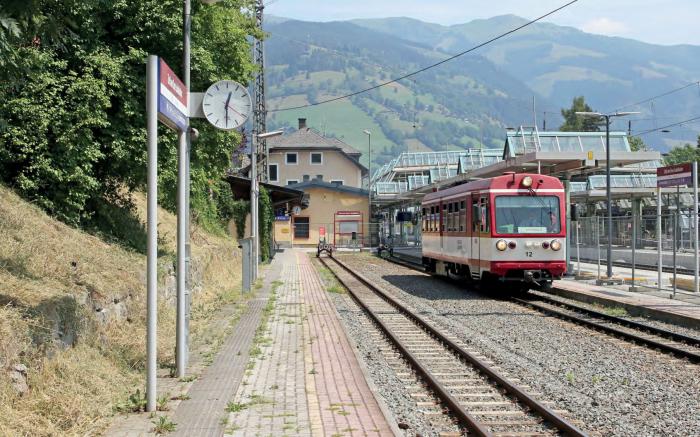
SANCTIONS FOLLOW OPENING OF RAIL LINK TO CRIMEA
In late January the American Government added eight individuals and Russian private rail passenger operator Grand Service Express to its sanction list imposed following the occupation and annexation of Crimea by Russia in 2014. The EU (of which the UK was then still a member) and Canada followed suit, sanctioning seven of the same people and Grand Service Express. The sanctions impact not only the individuals and Grand Service Express but also any non-Russian citizen conducting significant business with them.
The 19km double-track rail bridge over the Kerch strait (the longest in Europe) connecting south west Russia with the annexed Crimean peninsula opened to rail traffic on 23 December 2019. A DMU formed the opening special with Russian President Vladimir Putin enjoying a cab ride as part of the event. However, Russian Railways (RZD) does not operate services on the new link, the threat of sanctions limiting access to multiple European suppliers plus financial companies being enough to ensure operations are handled by nominally independent companies. All trains over the bridge are operated by the Russian Government owned Crimean Railway (KZD).
The new railway bridge over the Kerch Strait, just south and parallel with the new road bridge that opened on 15 May 2018, has been designed for electrification, with some overhead line support masts, but is currently not electrified. On the eastern bank RZD uses 25kV AC electrification and has undertaken substantial investment upgrading capacity and modernising the routes leading to the eastern side of the bridge at Taman. On the Crimean side 3kV DC electrification dating from the Soviet period is used on the Dzhankoi – Simferopol – Sevastopol main line, but the line from Dzhankoi linking with the new bridge was not previously electrified and part of it still isn’t, although modernisation and electrification at 25kV AC is planned. As the current operation deliberately avoids RZD operating trains on the new bridge, the fact trains have to change locos in Russia before heading to Crimea is not a real disadvantage, so the use of KZD diesel locos on the bridge and in eastern Crimea is unlikely to change in the near future.
Grand Service Express is an independent Russian passenger operator operating a form of open access service, albeit using rolling stock originally built for RZD and using RZD to provide traction in Russia. Grand Service Express has operated services between Moscow and St Petersburg since 2005 as well as the newly introduced services to Crimea. Two train pairs normally run each week from St Petersburg to Sevastopol and from Moscow to Simferopol. Passenger services via the new bridge started in late December 2019, and freight is due to begin this summer. Prior to the opening of the bridge a train ferry service for freight had operated. Ukraine suspended all land transport connections with Crimea in 2014 following the Russian annexation.
The road and rail bridges, which cost around $3.7 billion, have been controversial, not only because of the geo-politics but also concerns that the geology of the area is unsuitable for such structures. The bridges are not the first over the Kerch strait – the occupying German army started building a railway bridge via a shorter 4.5km route across the straits in 1943/44, which was completed by the Red Army as it liberated the region in 1944 and was used until destroyed by ice floes in early 1945.
AUSTRIA
ELECTRIFICATION FOR NARROW GAUGE LINES
Electrification by 2026 of the 52.7km 760mm-gauge Pinzgauer Lokalbahn line from the Austrian lakeside resort of Zell am See to Krimml has been agreed by the line’s owner, the state of Salzburg, which took it over from Austrian national operator ÖBB in 2008. The line has seen considerable passenger growth since its transfer from ÖBB, with over 900,000 passengers in 2018 and one million forecast in 2019.
It is currently operated by Salzburg region owned operator Salzburger Lokalbahn (SLB) using a mix of ex-ÖBB Class 5090 DMUs and push-pull sets hauled by 2007-built Gmeinder diesel locos. The fleet will require renewal in the mid-2020s, especially as parts for the Class 5090 units are now hard to obtain. Introduction of new hydrogen fuelled trains instead of conventional electrification (as planned for the Zillertalbahn in Tyrol) was considered and discounted. Planning is underway for a short extension from Krimml to the nearby waterfalls that draw many visitors; a feasibility study for an entirely new branch to the ski resort of Kaprun will also be undertaken.
Electrification at a cost of around €50 million is planned by 2026. Procurement for the new EMUs will be shared with the 66km-long ‘Murtalbahn’ (Tamsweg to Unzmarkt), which is jointly funded by the two states of Steiermark and Salzburg although operated by the Steiermark-owned Steiermärkische Landesbahnen (STLB). A new 10-year contract for STLB was agreed in December 2019 with 260,000 train kilometres annually funded. Electrification of this route is planned as it also uses life-expired Class 5090 design DMUs.
FRANCE
REGIONAL OWNERSHIP FOR REGIONAL LINES
The French Government has proposed that much of the country’s 9,137km of secondary passenger lines move to full or partial regional ownership/management. National infrastructure manager SNCF Réseau would retain around 17% (1,500km) of the existing network and relinquish or share responsibility for the remainder with the country’s 18 regional governments.
Previous proposals in the Spinetta review undertaken for the Government in 2018 that suggested closing around 9,000km of the secondary network have been quietly dropped. This is in part a result of the 2019 nationwide consultation following the gilets jaunes protests in 2018/19, which identified poor rural public transport as a key grievance (and as rail transport has historically been provided by state-owned SNCF, a grievance seen to be the Government’s ‘fault’).
THREE TIERS
The Government plan has utilised UIC (International Union of Railways) categorisation for lines (based on axle loadings, speed, usage etc) and identified the approximately 9,000km of passenger lines in classes 7 to 9 for attention, classifying them as tiers 1 to 3. The 1,500km of lines to be retained by SNCF Réseau as part of the national network (tier 1) are mostly either cross-country lines linking several regions (for example (Caen –) Mézidon – Alençon – Le Mans – Tours, straddling three regions – Normandy, Pays de la Loire and Center-Val de Loire) or busily trafficked lines also shared with TGV or freight (such as Blainville – Remiremont in Grand Est). The Government has indicated that around €1.4 billion will be made available to fund the necessary improvement work on this part of the network with a further €330 million from funding already agreed with the relevant regions.
Around 6,500km has been identified as important enough to be ‘shared’ between the regions and SNCF Réseau (tier 2) where Government funding may be available to bring lines up to modern standards. Funding for the ‘tier 2’ routes will be covered by the funding agreements in place between the central and regional governments in the future.
The final 1,000km in ‘tier 3’ are lines proposed for full transfer to the regions. The Government is requiring the regions to draw up plans for each tier 2 and 3 route, on a line by line basis, with the aim of prioritising investment. The future of the 2,900km of freight lines in France in the UIC categories 7 – 9 will be considered separately.
Under legislation passed on Christmas Eve (Loi d’orientation des Mobilités), the French regional governments now have the power to manage operation of lightly used railway lines. The new ‘Mobility’ law strengthens the role of regional governments in planning and financing public transport generally and commits France to banning the sale of new petrol/diesel cars by 2040 whilst increasing electric car charging infrastructure. The law also codifies planned Government funding for public transport, with €13.4 billion in the period to 2022 and €14.3 billion in the four years 2023-27; the bulk of this funding is for rail projects.
In late February the Center-Val de Loire region agreed to take over three ‘tier 3’ lines comprising:
■ Tours – Loches;
■ Tours – Chinon; and
■ the metre-gauge Salbris – Valençay line (the remains of the former CF du Blanc-Argent network).
Elsewhere, Grand Est agreed to take over three routes (Jarville – Vittel, Arches – Saint-Dié – Molsheim and Sélestat – Obernai) and agreement was pending in both Brittany and Région Sud (formerly known as Provence-Alpes-Côte d’Azur) concerning routes in those regions.
Whilst Brittany and Région Sud are planning to take over little-used railway lines they have very different plans to operate their regional train services. Région Sud is starting a tendering process for two groups of routes with the intention the new concession operator will take over from mid-2024; Brittany on the other hand signed a 10-year contract with SNCF in January covering all TER trains in the entire region and running to 2030.
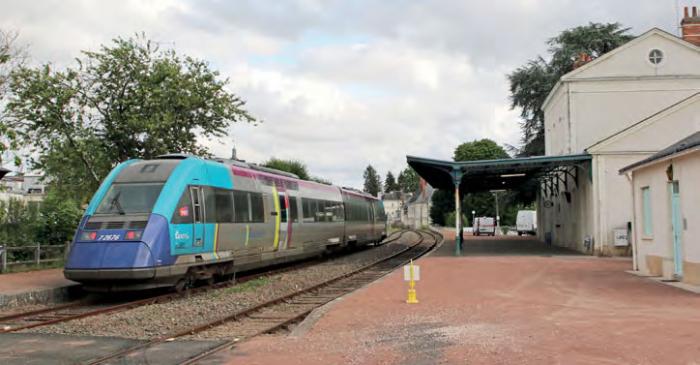
‘NO TABOOS’
Talking to local media in February, the French Transport Secretary stated there are ‘no taboos’ with competitive tendering (permitted from December 2019, and compulsory from 2023), with maintenance cost reductions, innovative new trains and replacement of rail services with alternatives all options available to the regions. The Government is particularly interested in very light trains (the idea of a 10-tonne vehicle with up to 100 seats has been mooted) and is funding some development research into this.
The sources of future finance remain opaque, with regions expected to fund substantial amounts of the infrastructure costs and a 12-year planning horizon discussed for ‘tier 2’ lines to be shared between regions and SNCF Réseau. The practicality of some of the suggestions is unclear; infrastructure maintenance cost reductions may be possible on the minority of secondary routes that have been modernised in the last decade, however for the majority of routes it is the cost of getting them into a fit state of repair that threatens their long-term future; the Government estimates this will cost at least €6.8 billion. Deferred maintenance and investment, especially in signalling, has left a large part of the network with deteriorating track quality and labour-intensive manual signalling.
The Government has talked about the potential for traffic growth through local management, and there is plenty of evidence in Germany, Austria and Switzerland of exactly this happening when regional governments gain control of not only the infrastructure but crucially the timetable and specify frequent services. Many of the ‘tier 3’ lines identified in France have almost no trains as high track access charges and ineffective accounting mean it is seen as ‘cheaper’ to run parallel buses other than at peak (school or commuter) periods, when trains are used. As the trains are generally idle when the buses are running (and vice versa), this leads to duplication of assets and costs. French tier 3 style lines with low train service levels only generate low track access revenues, in turn leading to low budgets for maintenance, reducing train speeds further and eventually leading to calls for closure.
If French regions look at the experience over the Rhine in Baden-Württemberg in southern Germany, they will see several ‘tier 3’ type lines, some of which were closed by DB in the 1960/70s, now thriving with frequent trains, often full. Some of these lines are now being electrified, such has been the traffic growth.
LUXEMBOURG
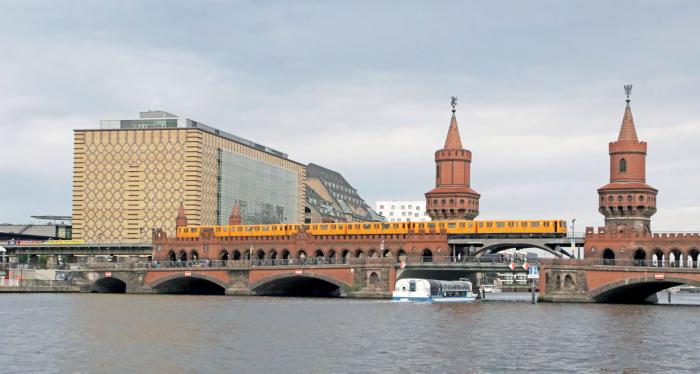
ETCS IN USE NATIONWIDE
Luxembourg, one of the smallest countries in Europe, has become the first European country to install European Train Control System (Level 1) on all railway lines – and to mandate the use of the system.
The national rollout had been long planned, with planning underway in 2005 and installation planned by 2017 – which was achieved. The political impetus for the mandatory use of ETCS was a head-on collision just inside Luxembourg near Bettembourg on the line to Thionville in France in February 2017, blamed in part on the existing Memor II+ signalling system; this was the second fatal accident on the same stretch of line in 11 years.
The practical consequences of both installing ETCS and then mandating its use on a network with substantial cross-border commuter traffic as well as international freight traffic is that train operators in neighbouring countries are required to equip their trains with ETCS or face them being banned from operating in Luxembourg. ETCS usage was mandated from 1 January 2020, as the old Memor II+ electromagnetic safety system was taken out of use on almost all the network, but despite over a decade of advance notice the majority of the 25 French Railways (SNCF) EMUs used for frequent cross-border commuter traffic were not equipped with ETCS in time. A derogation previously issued by the Luxembourg rail regulator to SNCF (until mid-2021) was withdrawn after the Bettembourg accident enquiry identified the Memor II+ signalling system as a cause. As a consequence, travellers from French cities in Lorraine (around 12,000 daily) do not have as many through trains as previously, having to change from an SNCF to a CFL service in Thionville.
Similar problems have been experienced between Luxembourg and Arlon in Belgium due to a lack of ETCS-fitted trains, although Belgian operator SNCB has equipped part of its Class 13 electric loco fleet and is working to equip more of its Desiro EMUs with the necessary equipment. Testing for use of SNCB Siemens-built Class 18 Eurosprinter locos in Luxembourg is also underway; when completed these should be able to operate services on the Brussels – Namur – Luxembourg route in addition to Class 13. On the alternative route between Belgium and Luxembourg, from Liège, SNCB has operated dual-voltage Desiro ML EMUs equipped with ETCS since December 2019, replacing loco-hauled trains.
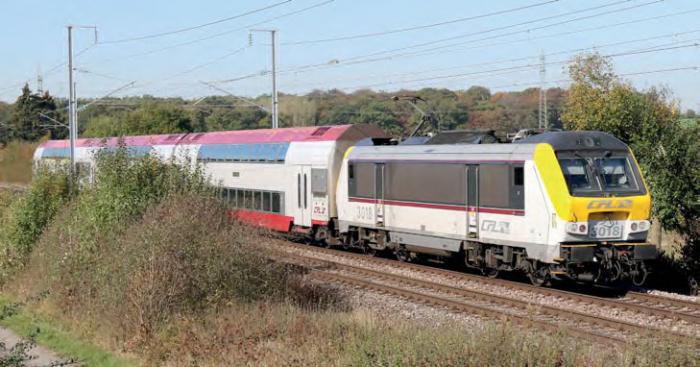
For freight, dispensation has been granted for 2020 for freight trains to still run with Memor II+ operating on the Belgium – Luxembourg – France TEN (Trans-European Network) corridor avoiding Luxembourg City from Bettembourg to Rodange via Esch/Alzette and Pétange. From 1 January 2021 all freight operators using the route will be required to use ETCS.
GERMANY
STADLER FINALLY WINS €3BN BERLIN U-BAHN ORDER
Berlin transport operator BVG announced a €3 billion order with Stadler for 1,500 new vehicles to enable largescale replacement of the existing U-Bahn fleet in 2018. Legal challenges from Siemens delayed the contract being finalised, although this legal action was dropped in May 2019. However, another unsuccessful bidder, Alstom, continued to fight the BVG decision, launching new legal action in late August 2019. This action was finally dismissed by the courts in late February, enabling BVG to proceed with the contract.
BVG changed key aspects of the order whilst the tender was underway in 2016/17, increasing the number of vehicles being ordered from 1,050 to 1,500 whilst adding requirements for the manufacturer to take on warranty and availability responsibilities for up to 32 years. Originally the first 24 vehicles were due in service from 2021.
The final contract as signed has a firm order for 606 vehicles to be delivered as two-car and four-car EMUs; initially 376 cars will be built with the next 230 to be ordered later. An option for a further 894 vehicles is within the framework order. BVG has two basic types of train – large and small profile – referring to the loading gauge of the lines they are used on. The Stadler order comprises trains of both profiles (small profile trains will be ‘type JK’, large profile trains ‘type J’), enabling replacement of the oldest trains on the network (some of which date back to the 1960s). The first of the new trains should be delivered in 2023 with series production running to 2033. Stadler will assemble the trains in Berlin at its existing Pankow factories, where it will invest €70 million.
U-BAHN FOR FREIGHT?
In mid-February German Federal transport minister Andreas Scheuer proposed government funding for a night-time trial of package delivery using existing U-Bahn systems. The proposed ‘Paket U-Bahn’ would operate from around 02.00 after the end of normal passenger service and distribute parcels and small packages to existing or new temporary storage/delivery facilities at or near U-Bahn stations for collection by the recipients of the parcels in the morning. Package delivery company DHL, which is owned by German postal company Deutsche Post, has already set up a network of delivery lockers at many main line and some suburban and U-Bahn stations, although these are currently serviced by delivery staff using road transport.
The ‘Paket U-Bahn’ concept would also allow package delivery ‘micro-hubs’ to be established at stations, from where couriers using electric bikes could deliver in the locality, reducing the number of delivery vans on the streets, the increase in number of which delivering online orders has added to congestion in many cities across the world. It is unclear how the German Government will fund the trial or where it will be; progress with the planning will inevitably have been delayed by the coronavirus pandemic.
The concept of freight being carried on urban railways (mainly tramways) is not new and was common in the early 20th century, although it is now much less common. Both London and Chicago used to have dedicated underground rail systems for mail and parcels, although neither is still in use.
IRELAND
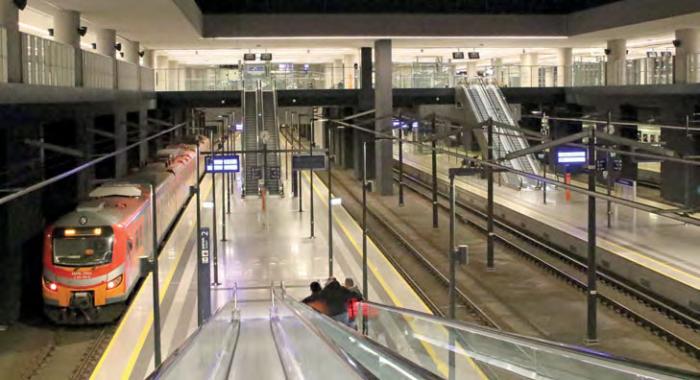
IÉ TRIALS NEW FREIGHT SERVICE
Iarnród Éireann (IÉ) has operated a trial freight train for global logistics company XPO. The service between Ballina in County Mayo and Waterford Belview Port operated on 10 March with nine 14.5-metre LX-type flat wagons hauled by 201 Class locomotive No 222. It carried refrigerated containers and on arrival at the port the containers were off-loaded and transferred to a ship for onward transport to Rotterdam.
XPO is keen to help its customers lower their carbon footprint, with rail having the potential to reduce emissions by up to 75%. In addition to lowering the number of trucks on busy roads, use of rail also alleviates the present shortage of HGV drivers. If the trial is deemed successful, the new freight service is expected to commence later this year. In 2019, freight traffic represented 71.6 million tonne kilometres in Ireland. Tim Casterton
POLAND
ŁÓDŹ CROSS-CITY TUNNELLING UNDERWAY
Work to build a new double-track railway under the Polish city of Łódź, the third largest city in the country, is now underway. The new line will link the Łódź Fabryczna terminus, itself a new underground station that opened in December 2016 on the site of its predecessor which closed (for rebuilding underground) in October 2011. The new 3km-long double-track line, which will be up to 24 metres below the surface, will be made using a 13.04-metre diameter tunnel boring machine (TBM) supplied by German specialist Herrenknecht, which was delivered to Łódź in late March. Once assembled the TBM will drive east from the initial start chamber (constructed in 2019) to Łódź Fabryczna.
At the western end of the new tunnel a ‘Y’ shaped underground set of tunnels (totalling 4.5km) will allow trains to head north (towards Kutno/Poznan/Bydgoszcz) via Łódź Żabieniec and south via the city’s other major station, Łódź Kaliska, towards Wroclaw and Katowice. Herrenknecht has supplied a separate 8.76-metre diameter TBM to construct these four sections. In total 17km of new track is planned.
Two stations are planned on the new cross-city line in the city centre and construction should be complete by December 2022. The project is part of the TEN programme and the EU is providing PLN1.43 billion (£280 million) of the PLN1.76 billion (£342 million) project cost. Once complete the new tunnel plus the approximately 3km mostly cut and cover four-track tunnel section between Łódź Fabryczna and Łódź Niciarniana / Łódź Widzew that opened in 2016 will enable many new journey possibilities for local services and much faster transit of the Łódź conurbation for long-distance services.
